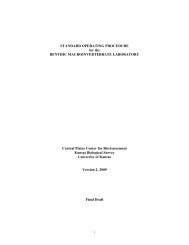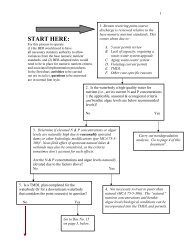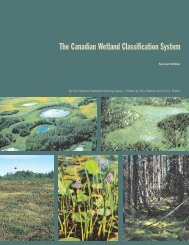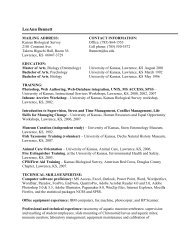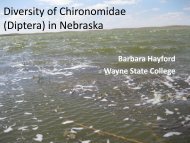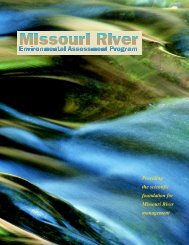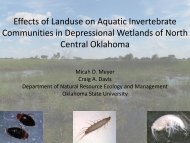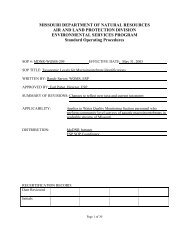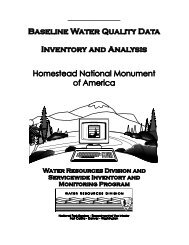Koontz, J., D.G. Huggins, C.C. Freeman, D.S. Baker - Central Plains ...
Koontz, J., D.G. Huggins, C.C. Freeman, D.S. Baker - Central Plains ...
Koontz, J., D.G. Huggins, C.C. Freeman, D.S. Baker - Central Plains ...
Create successful ePaper yourself
Turn your PDF publications into a flip-book with our unique Google optimized e-Paper software.
MMI Scores<br />
Palustrine Wetland Class MMI Scores<br />
100<br />
90<br />
80<br />
70<br />
60<br />
50<br />
40<br />
30<br />
20<br />
10<br />
0<br />
100<br />
90<br />
80<br />
70<br />
60<br />
50<br />
40<br />
30<br />
20<br />
10<br />
0<br />
a<br />
Lacustrine Palustrine<br />
Wetland Class<br />
Riverine<br />
c<br />
1 2<br />
Wetland Class<br />
Lacustrine Wetland Class MMI Scores<br />
Figure 54. Median Box plots showing the distribution of MMI values among wetland classes<br />
and statistically significant differences within classes between Phase I and II. Box area<br />
represents inner quartile range, while “whiskers” represent the upper and lower observations.<br />
MMI Result Conclusions<br />
Tests of MMI‟s response to measures of floodplain connectivity including the DTF, distance<br />
from the Missouri River Channel, and measured distance between the sample wetlands did not<br />
reveal any significant relationships between the MMI and measures of connectivity. The MMI‟s<br />
significant correlation to the mean conductivity mS/cm measure was the only indirect evidence<br />
that hydrological connectivity might be affecting wetland macroinvertebrate community<br />
structure, given that mean conductivity also had significant relationships to the DTF and distance<br />
from the Missouri River channel measure. Despite this the MMI did show consistent<br />
congruency with the other wetland assessment indices and water chemistry metrics, providing<br />
evidence that the Phase I reference sample population overall had greater wetland quality. The<br />
strongest feature of this MMI is that does not significantly respond to potential ecoregion, class,<br />
or type differences, yet it can discriminate reference candidates from the random population<br />
regardless of the spatial location of the wetland or classification. The combination of highly<br />
responsive individual macroinvertebrate metrics to multiple stressors contributes to a robust<br />
measure of biological integrity across a variety of wetland types and classes within this study<br />
population.<br />
100<br />
90<br />
80<br />
70<br />
60<br />
50<br />
40<br />
30<br />
20<br />
10<br />
0<br />
74 of 84<br />
b<br />
1 2<br />
Wetland Class



